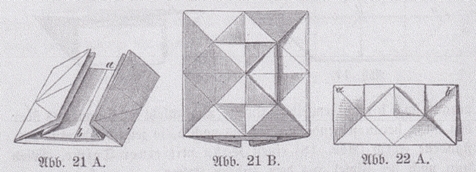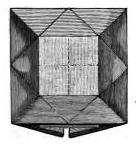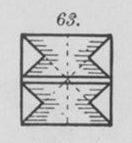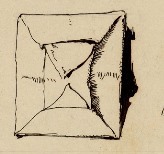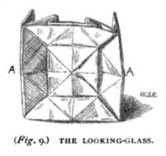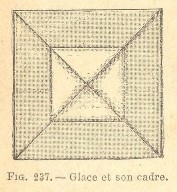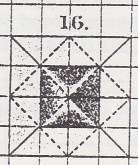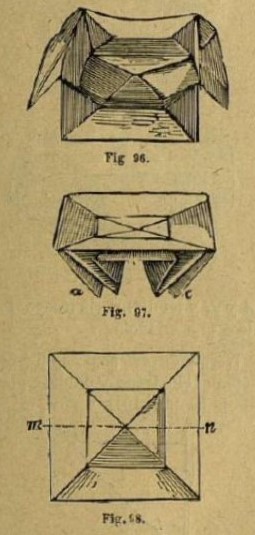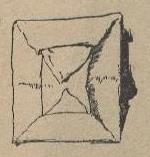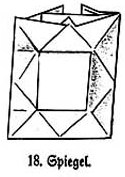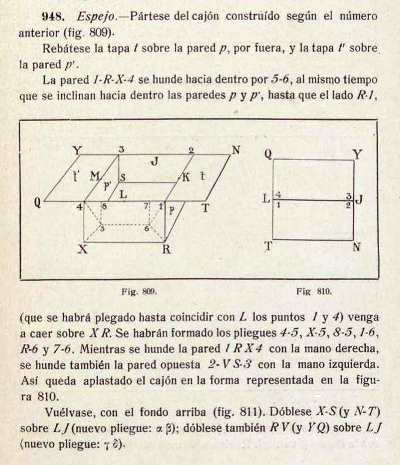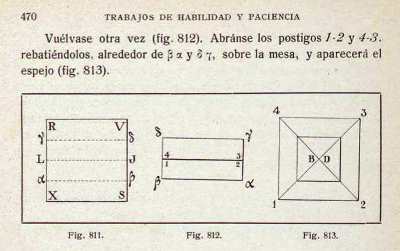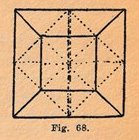| The Public Paperfolding History Project
Last updated 10/12/2025 x |
|||||||
| The Mirror / The Looking Glass / The Hour Glass | |||||||
| This
page is being used to collect information about the
history of the paperfolding design known as the Mirror,
which is folded from a windmill base and of the same
design folded from a blintzed windmill base, which, in
order to distinguish the two, will be referred to on this
page / site as The Looking Glass. Please contact me if
you know any of this information is incorrect or if you
have any other information that should be added. Thank
you. The Mirror is developed from the Frame and can in turn be developed into the Gondola. The Looking Glass is developed from the Picture Frame and can in turn be developed into the Chinese Junk. Where the context is insufficient it can be difficult to know which of the two versions of the design is being pictured or referred to. It is possible that I have made mistakes when trying to work out which is which. ********** 1848 'Die Kindergärten' by Wilhelm Middendorf was published by Verlagsbuchhandlung der Kindheit und Jugendbeschäftigungsanstadt in Blankenberg and Rudolfstadt in 1848. It contains a description of children folding Lebensformen which mentions a 'Spiegel' which, in the context, can be identified as The Mirror. ********** 1859 Both designs appear as 'Le miroir' in separate lists of designs in the 'Manuel Pratique de Jardins D'Enfants de Friedrich Froebel, which was compiled by J F Jacobs and published in Brussells and Paris in 1859. In this case, although there are no illustrations in the book, the context makes it clear which design is which. ********** 1861 There is mention of a design titled 'Spiegel' (mirror) in a list of 'Lebensformen' (Forms of Life) in 'Das Paradies der Kindheit' (The Paradise of Childhood) by Lina Morgenstern, which was published in Leipzig in 1861. Unfortunately there is no illustration of the design. ********** 1863 A design called 'De spiegel' (the mirror) appears in 'De Kleine Papierwerkers 1: Wat men van een stukje papier al maken kan: Het vouwen' (The Small Paperwork 1: What one can make from a piece of paper: Folding) by Elise Van Calcar, which was published by K H Schadd in Amsterdam in 1863. Since it is made by collapsing the sides of the Junk Box it must be the Looking Glass.
********** 1869 'Paradise of Childhood' by Edward Wiebe, which was published by Milton, Bradley and Company in Springfield, Massachusetts in 1869, and is effectively a translation of Goldammer's 'Der Kindergarten', includes a 'Looking-glass' in its list of Forms of Life. There is no accompanying illustration. ********** 1873 The design appears as 'Spiegel' in 'Die Praxis Des Kindergartens' by August Koehler was published by Herman Bohlau in Weimar in 1873.
********** 1874 The third edition of 'Der Kindergarten' by Hermann Goldammer, which was published by Carl Babel in Berlin in 1874, mentions, but does not picture, a design titled 'Den Spiegel (the mirror) From the context this is probably either the Mirror or the Looking Glass. ********** 1875 As 'Den spiegel' in 'Froebels Methode' by Elise Van Calcar, which was published in 1875.
********** 1876 The Looking Glass design also appears in 'Des Kindes Erste Beschaftigungsbuch' by E Barth and W Niederley, which was first published in Bielefeld and Leipzig, and the foreword of which is dated October 1876.
********** 1880 In 'Maakt de Kinderen Gelukkig' by Elise Van Calcar, which was published by H C Van Calcar in Gravenhage in 1880, there is a probable reference to the Looking Glass design as 'de spiegel' (the mirror), although no illustration is provided. ********** 1880 The Mirror appears in 'The Kindergarten Principle' by Mary J Lyschinska, which was published in London in 1880 by Wm Isbister Ltd,where it is called 'The Looking Glass'
********** 1882 This design also appears as 'The Looking Glass' in part two of 'The Kindergarten Guide' by Maria Kraus Boelte and John Kraus, which was probably first published in 1882 by E. Steiger and Company in New York.
********** 1883 A drawing of the Mirror appears in a pictorial story by Apeles Mestres dated 2nd August 1883 found in his Llibre Vert III.
********** 1887 The Looking Glass appears as 'Miroir' in 'Le Travail Manuel a L'ecole Primaire' by M. Coste et J. Lapassade, which was published by Lafon, Vve Ribaut et Tonnet in Pau and A Jeande in Paris in 1887.
********** 1888 The Looking Glass appears in 'Wide Awake: Volume Z', which was published by D Lothrop Company in Boston in 1888.
********** 1890 Diagrams for 'Une glace a cadre' appear in 'Les travaux manuels a l'ecole primaire a l'usage des ecoles de garcons' by Dauzat and Deramond, which was published by Alcide, Picard et Kaan in Paris in 1890.
********** The Looking Glass appears as 'Glace' in 'Le travail manuel a l'ecole et dans la famille' by MM, Bertrand, Toussaint and Gombert, which was published by Loucene, Oudin et ces Editeurs in Paris in 1890.
********** 1891 The Looking Glass also appears in 'Pleasant Work for Busy Fingers' by Maggie Browne, which was published by Cassell and Company in London in 1891. This book is an English version of 'Des Kindes Erste Beschaftigungsbuch' enhanced by the addition of a few extra designs. ********** 1893 The Looking Glass appears as 'Glace et son Cadre' (Mirror and it's Frame) in 'L'Annee Preparatoire de Travail Manuel' by M P Martin was published by Armand Collin & Cie in Paris in 1893.
********** 1895 A design that appears to be the Looking Glass appears as 'An Hour Glass' in 'Course of Paperfolding' by Eleonore Heerwart, which was published by Charles and Dible in London and Glasgow in 1895.
********** 1902 The Looking Glass appears as 'Espejo' (Mirror) in 'Guia Practica del Trabajo Manual Educativo' by Ezequiel Solana, which was published by Editorial Magisterio Español in Madrid in 1902.
********** 1907 An article titled 'El trabajo manual escolar' by Vicente Casto Legua in the January 1907 issue of the Spanish magazine 'La Escuela Moderna', which was published in Madrid by Los Sucesores de Hernando, mention a design called 'Espejo'. No illustrationis given but from its position between the Junk Box and the Chinese Junk it must be the Looking Glass. ********** 1908 In the last ever issue of the Catalan satirical magazine 'La Campana Catalana', published in Barcelona on 29th April 1908, in a cartoon by Apeles Mestres which pictures a variety of paperfolding designs. This pictorial story had previously been published in his Llibre Vert III in 1883.
********** 1910 As 'Der Spiegel' in Part 2 'Das Flechten' of 'Die Frobelschen Beschaftigungen' by Marie Muller-Wunderlich, which was published by Friedrich Brandstetter in Leipzig in 1910.
********** The Mirror appears as As 'Stehspiegel' in 'Allerlei Papierarbeiten' by Hildergard Gierke and Alice Kuczynski, which was published by Drud und Verlag B G Teubner in Leipzig and Berlin in 1910.
********** As 'A Tray' in 'Handicraft in the School', which was issued in four volumes by Gresham Publishing in London in 1910.
********** 1918 As 'Espejo' in 'Ciencia Recreativa' by Jose Estralella, which was published by Gustavo Gili in Barcelona in 1918.
********** 1928 'Fun with Paperfolding' by William D Murray and Francis J Rigney, which was published by the Fleming H Revell Company, New York in 1928, contains a picture of the Looking Glass, although it is treated as just an intermediate form rather than a design in its own right.
********** 1931 As 'Spiegel' in the revised 3rd edition of 'Lustiges Papierfaltbüchlein' by Johanna Huber, which was published by Otto Maier in Ravensburg, Germany in 1931.
********** 1939 As 'Espejo' in 'Trabajo Manual Educativo' by Araminta V Aramburu, which was published by F Crespillo in Buenos Aires in 1939.
********** 1951 As 'Cadre' in 'Occupons nos doigts' by Raymond Richard which was published by Les Editions du Cep Beaujolais in Villefranche-sur-Rhone in 1951.
********** |
|||||||



